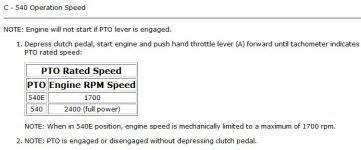I do not bring it up from idle. That is not a feasible situation in my real world. I cannot idle down every time I want to begin mowing.
I have no strange noises. Everything begins and appears fine. It begins spinning, and everything is smooth, but I think the stress of getting all that metal moving simply overcomes the shear force of the pin.
I am extremely limited on what I can add as far as size of a bigger bolt. There simply isn't very much 'meat' to drill out and maintain integrity.
If I try to weld it (and I'm not sure whether it is cast steel or iron) and add an adaptable slip clutch at the machine, will that 'work' as far as protection of the tractor? I was able to find a slip clutch at TSC which slips over the shaft at the gear box, and onto which the PTO shaft can be attached. At least that is what it appears to be set up for. I thought, perhaps if I weld the 'shear pin pieces' together, then I could still protect things with the clutch. Any thoughts about this?
The only other thing I can do is to purchase a completely new PTO shaft with a slip clutch integrated already. This is probably what I should do. Get a new PTO shaft Series 6 or 8 with a CV joint and a slip clutch. I am sure this would cure 'all' the problems which have arisen.
IF anyone has a recommendation on where I can find such a shaft collapsed length of 72" with at least 18" working expansion, please link me or give me a name. The length that is required is making it difficult to find.
View attachment 514946
View attachment 514948View attachment 514949

